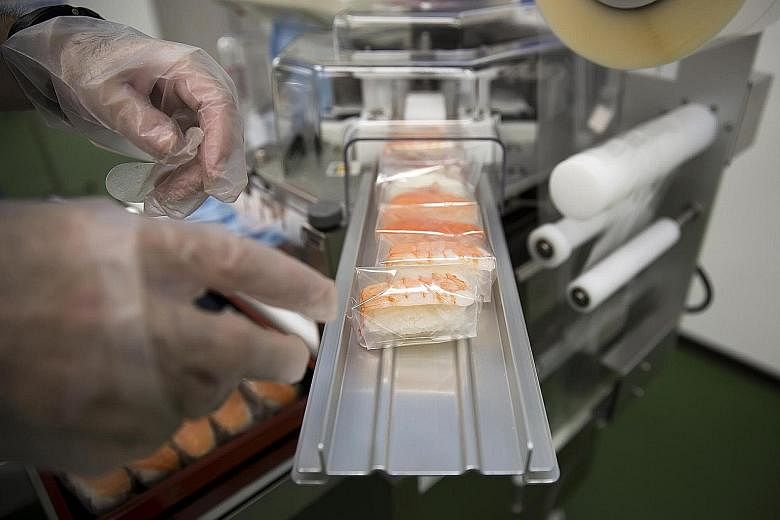TOKYO • Mr Kisaku Suzuki, creator of the world's first sushi robot, once ran a company that made candy- wrapping machines. And he was angry.
Why had the Japanese government embarked on a policy to limit rice production, effectively paying some farmers to keep their paddy fields idle? For Mr Suzuki, rice was the sacred heart of the country's economy. He started to think about how to make the staple food more popular so that Japan had no reason to restrict the crop.
And that was when it came to him: He would use his firm's knowledge of candy-packaging machines to develop the robot. The idea, while off-the-wall in the mid-1970s, had a simple premise.
If he could lower the cost of making sushi by mechanising parts of the process and reducing the need for highly paid chefs, he could bring the previously elite Japanese dish to the masses and, in doing so, increase the demand for rice.
Four decades later, Suzumo Machinery Co's robots are used by about 70,000 customers around the world, ranging from sushi chains to factories, and account for about 70 per cent of the market for the equipment at restaurants, according to Suzumo's estimates.
Kaiten sushi, also known as conveyor-belt sushi, has become a US$6-billion (S$8-billion) industry in Japan alone, partly thanks to Mr Suzuki's invention.
Cheap sushi "couldn't have happened without our machines", says Mr Ikuya Oneda, who succeeded Mr Suzuki as Suzumo president in 2004, a year before the founder died.
When Mr Suzuki started to create his robot, he met resistance. In 1976, sushi was still largely a food for special occasions. It was mostly sold through a legion of small restaurants, where artisan chefs dispensed morsels with no price tags and charged what they saw fit.
Not surprisingly, those chefs were up in arms when they heard about Suzumo's plan. In their view, it took 10 years to train someone to make sushi. No machine could possibly do the job.
Suzumo asked some of the people it was trying to depose to give their opinions on the prototype. "They said, 'This is no good, this is terrible, I don't know what this is,'" said Mr Oneda, 73, who became chairman of the company this year.
After three years, Suzumo was nowhere near its goal and running out of cash. Company officials feared "the company would go down the tubes", Mr Oneda said. "We thought about quitting."
Suzumo stuck with the task and, two years later, the sushi chefs said the machine was usable. In 1981, the company completed its first robot, which formed sushi rice into balls called nigiri. These days, it offers 28 different sushi machines.
"What they've done is allow kaiten restaurants to democratise and make good Japanese food affordable and accessible," says Mr Robin Rowland, chairman and chief executive officer of Yo, a British sushi chain with almost 100 restaurants globally. "We serve seven million guests a year. You're talking about 500 to 600 dishes on our belts in Britain. It's a lot of food. You need to automate some of that."
But so many years later, the machine debate still rages on. For purists, if you use robots, it just is not the same."It's an entirely different genre," says chef Yoshikazu Ono, son and heir of Jiro Ono, the chef featured in the 2011 documentary Jiro Dreams Of Sushi.
"Sushi isn't just balls of rice. The process is the most important thing. It requires relentless practice to make just one piece of sushi rice - things like how you select, prepare and cook the rice. You can't get that from a robot."
Already, about three-quarters of Japanese say when they eat sushi, it is from a conveyor belt, according to a survey published by fishery company Maruha Nichiro Corp in March. Almost half of them choose which restaurant to go to based on price.
Michael Booth, a food writer whose latest book, The Meaning Of Rice, is set for publication next month, sees room for both types.
"I want everyone to get a chance to taste what amazing sushi from Jiro is like because it's a different experience," Booth says. "But then again, cheap, mass-produced sushi is like the entry drug into the sushi world and that can be a good thing too.
"People are exposed and may become curious as to what great sushi tastes like."
WASHINGTON POST

